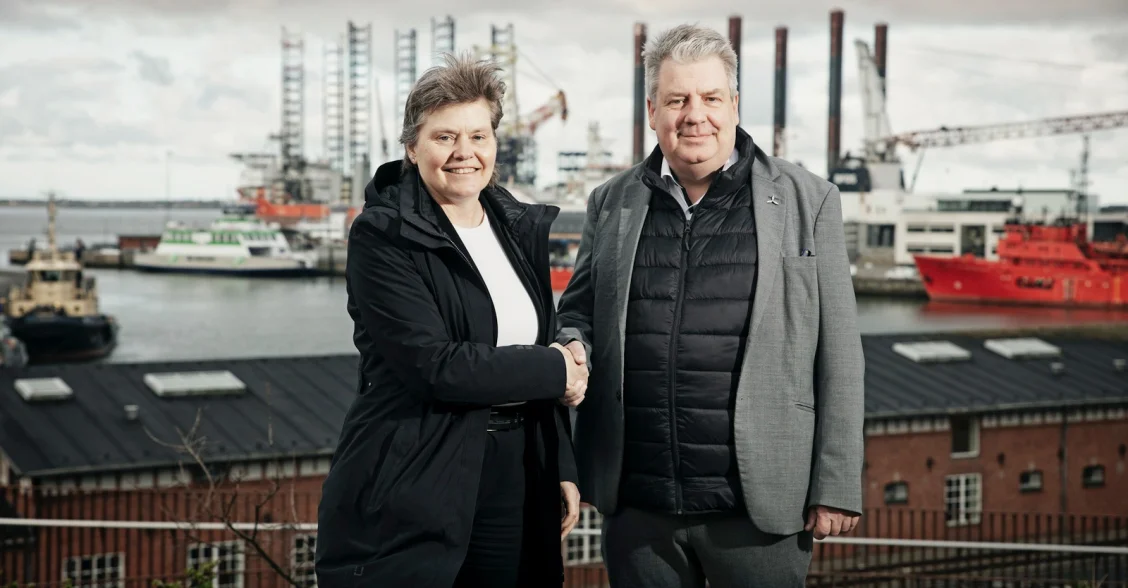One of the world’s largest originating ports for wind power, Port Esbjerg, and Norwegian Port operator, WindPort, has entered a strategic partnership to strengthen its position in the Norwegian offshore wind industry. The collaboration combines Esbjerg’s extensive expertise with WindPort’s ideal location and ambitions to become the primary marshalling hub for the Sørlige Nordsjø II (SNII) offshore wind project.
Historically, WindPort has served the oil and gas sector from its location as Norway’s southernmost deep-water port in Mandal. However, moving forward, the port will also be able to support offshore wind operations.
That is why WindPort has seen great value in establishing a partnership with Port Esbjerg – a collaboration that is now becoming a reality.
“Port Esbjerg is widely regarded as one of the most experienced offshore wind ports globally with unique capabilities. Learning from their experience and know-how enables us to build smarter from the start and position WindPort as a top-tier marshalling hub,” says Turid Storhaug, Managing Director at WindPort AS.
The collaboration with Port Esbjerg is a central part of this transition. Going back through the history books, Port Esbjerg became Denmark’s oil and gas capital following the discovery of oil in the North Sea in 1966.
Around the turn of the millennium, offshore wind emerged as a new business area, and Port Esbjerg became Europe’s leading hub for the shipment of offshore wind turbines.
It is the transformation away from fossil fuels and towards renewable energy, that have inspired WindPort.
A partnership for progress
The partnership focuses on joint project development and knowledge sharing in areas such as quay design, logistics, sustainable energy practices, and new fuel technologies.
Sharing knowledge and experiences to power and scale the offshore wind industry are at the core of the agreement.
Port Esbjerg brings unique capabilities in handling large offshore installations and has a proven track record in servicing Europe’s offshore wind supply chain. And now also for supporting the build out of the Norwegian offshore wind sector in the southern part of the Norwegian North Sea.
“WindPort has already proven itself as a highly capable maritime hub with strong infrastructure and a clear vision for offshore wind. They are already ahead of the curve, and our collaboration is about unlocking even greater potential. Together, we can set new standards for how ports support the offshore wind industry - efficiently, sustainably, and smart from the start,” says Dennis Jul Pedersen, CEO at Port Esbjerg.
WindPort currently has ~200,000 square meters of space and has potential to develop up to 1 million square meters across three fjordside locations.
Its deep and obstruction-free navigation channel - with no need for further dredging or adjustments - makes it ideally suited for large vessels used in offshore wind installations, with a short distance from the fjord to the open sea.
Strategically located in the deep-water port in Mandal, Norway, the Port offers significant potential for redeeming their ambitions.
One clear ambition
WindPort’s goal is to become the WTG (Wind Turbine Generator) marshalling port and a key logistical hub for offshore wind farm development. The focus is set on the Sørlige Nordsjø II (SNII) offshore wind project.
SNII is the first major offshore wind project on the Norwegian continental shelf. SNII will consist of an estimated 60-100 wind turbines with a total capacity of 1.5GW, and an almost 200 km HVDC-link, connecting the offshore wind farm with the existing substation in Kvinesdal in the south of Norway.
This requires investments in quay expansion and overall port development.
In preparation for SNII, WindPort is planning to invest heavily in upgrading its quay facilities and operational infrastructure. A strong local ecosystem of multidiscipline service providers - with maritime oil and gas backgrounds - further supports WindPort’s readiness for the offshore wind transition.
“This is a long-term opportunity for both Norway and WindPort. By collaborating with Port Esbjerg and obtaining knowledge on effective port management, we are not only accelerating our transformation but also contributing to the sustainable energy future of Northern Europe,” says Turid Storhaug.
Go to overview

